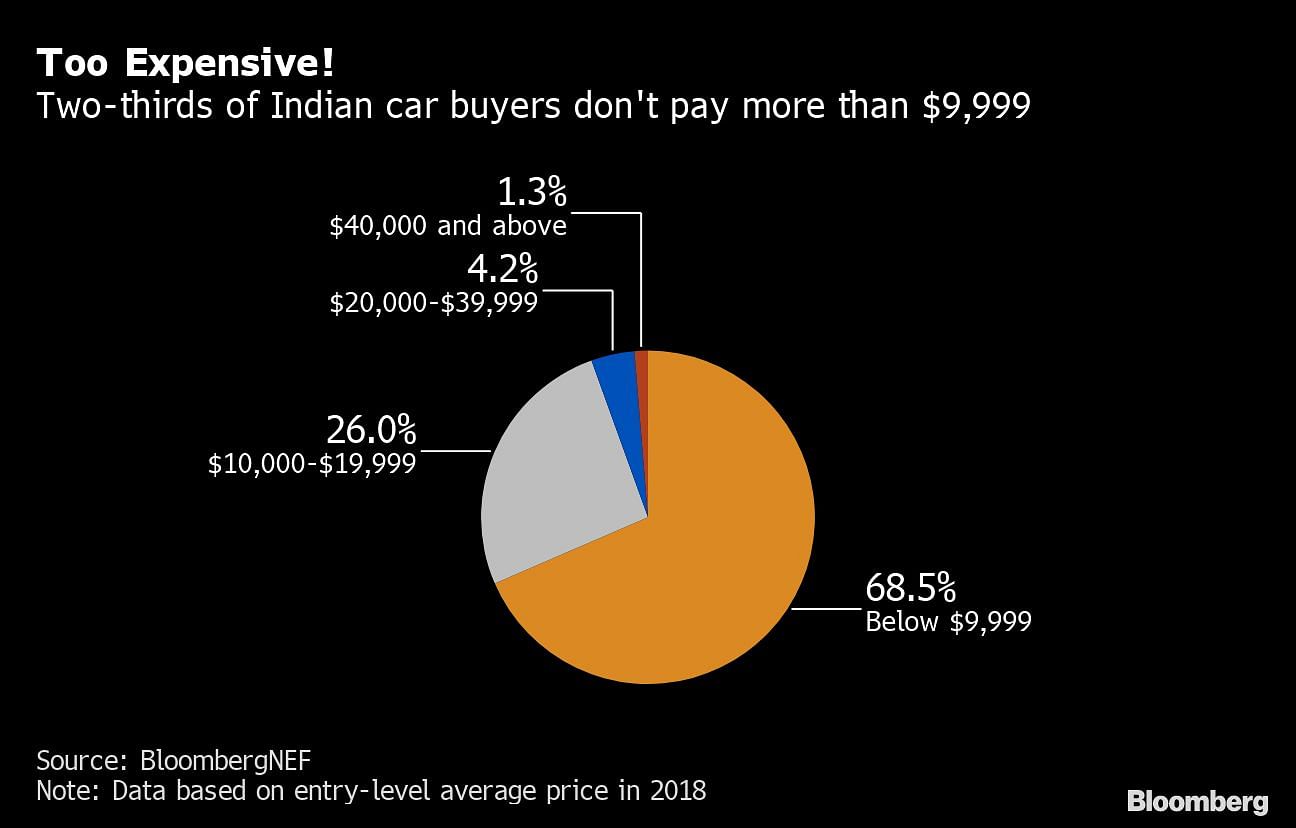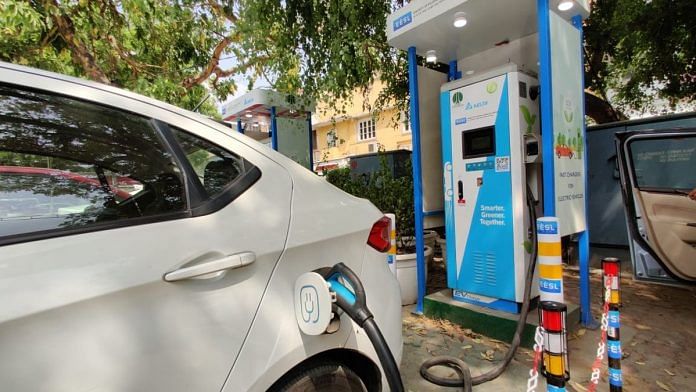New Delhi: Hyundai Motor Co. launched India’s first electric SUV this summer with a quirky TV commercial urging millennials to “Drive Into the Future.” A few months later, the automaker finds itself on a lonesome road.
In a nation of about 150 million drivers, only 130 Kona SUVs were sold to dealers through August. That slow pace is emblematic of the difficulties carmakers face in establishing an electric foothold in the fourth-biggest auto market, even with committed government support.
The Kona sells for about $35,000 while the average Indian earns about $2,000 a year — and the best-selling gas guzzler costs $4,000. Yet Kona’s sticker price only kicks off the conversation about why EVs aren’t gaining traction in India — there’s also a lack of charging infrastructure, a reluctance by banks to finance purchases and an unwillingness among government departments to use EVs as directed.
Barely more than 8,000 EVs were sold locally during the past six years, according to data compiled by Bloomberg. China sells more than that in two days, according to BloombergNEF projections.
“The affordability of electric cars in India is just not there,” said R.C. Bhargava, chairman of Maruti Suzuki India Ltd., maker of the sales leader Alto. “I don’t think the government or the car companies expect that in the next two to three years there will be any real buying of electric vehicles.”
The segment still isn’t making meaningful strides more than four years after the government started promoting cleaner vehicles for one of the world’s most-polluted countries. In February, Prime Minister Narendra Modi’s administration committed to spending $1.4 billion on subsidies, infrastructure and publicity.
The potential of India’s EV market can’t be ignored. There are only 27 cars for every 1,000 Indians, compared with 570 for the same number of Germans, giving global automakers an opportunity to challenge the dominance of Maruti –- the unit of Japan’s Suzuki Motor Corp. that sells every other car on local roads.
Maruti’s not introducing its first EV until next year. Tata Motors Ltd. and Mahindra & Mahindra Ltd. build some base-level electric cars, yet they have a limited range or are exclusively for government use. The Kona gives Hyundai a first-mover advantage in a market where EVs may comprise 28% of new vehicle sales by 2040, according to BNEF.

Not only Hyundai sees opportunity in Asia’s third-largest economy. MG Motor, the iconic British carmaker owned by China’s SAIC Motor Corp., and Japan’s Nissan Motor Co. see EVs as a way to expand in the country.
“Somebody has to take the leadership, and it will trickle down,” said Rajeev Chaba, managing director of MG Motor India, which plans to launch an electric SUV by December.
The process of scaling up will be slow, and MG Motors would be satisfied selling 100 cars a month initially.
“We have to start somewhere,” Chaba said.
Right now, though, consumers pass over electric cars for bigger, longer-range and cheaper gas guzzlers, said Vinkesh Gulati, vice president of the Federation of Automobile Dealers Associations, which represents more than 80% of automobile dealers in India.
More than half of the passenger vehicles sold in India last year cost $8,000 or less, according to BNEF. Electric cars won’t achieve price parity with gasoline-powered cars until the early 2030s, BNEF said.
“Consumers care about EVs, the excitement is there,” Gulati said. “But that stops the moment we tell them the price.”
Also read: Why Modi govt’s push for electric vehicles alone won’t solve India’s air pollution crisis
Yet even for those who can afford the Kona, plugging in is problematic. Nidhi Maheshwary, a 40-year-old finance professional working near New Delhi, wanted to buy an EV to show her children an example of environmental responsibility.
So when Hyundai launched the Kona, Maheshwary ordered one. Sounds easy, but it didn’t turn out that way.
Almost immediately, she got into a spat with neighbors about charging the SUV in her apartment building’s basement lot. The residents’ society said it posed a fire risk -– even though Hyundai engineers and the fire department said it was safe.
So Maheshwary charges the car at her office while weighing potential recourse against those neighbors. Hyundai offers two small chargers with the Kona, although it can take as many as 19 hours to fill up the vehicle.
India had an estimated 650 charging stations for cars and SUVs in 2018, according to BNEF. China, the largest market for EVs, has about 456,000 charging points, official data shows.
India’s sparse charging infrastructure stems from locals’ chicken-and-egg approach to the issue.
At a conference in New Delhi last month, government officials and EV-component makers debated whether to create adequate charging infrastructure to promote sales or whether to wait until there are enough EVs on the roads before building it out.
“We are pretty sure that people are going to like our EV, but we would have our challenges like infrastructure,” Chaba said. “But we have our plans to handle that.”
Those include first requiring that the buyer can install a charger at home, he said.
But there’s another factor besides income that makes it difficult to pay for one of these cars. The unaffordability of EVs also stems from the unavailability of financing, said Pranavant P., a partner at Deloitte India focusing on the future of mobility.
Until there’s an established secondary market for EVs, banks and other institutions are hesitant to extend purchasing loans, he said. A majority of Indian vehicle sales are financed by lenders.
The government, both federal and local, will have to offer help for EVs to be adopted in the mass market, said Puneet Anand, group head of marketing at Hyundai Motor India. Modi’s budget in July included incentives such as reduced taxes, income tax benefits and import duty exemptions for certain EV parts.
The first beneficiaries will be the ubiquitous scooters and motorcycles — with subsidies meaning to support sales of 1 million two-wheelers, compared with 55,000 electric cars.
Yet the government still needs to practice what it’s preaching. Energy Efficiency Services Ltd., a joint venture of state-run companies responsible for replacing state vehicles with EVs, awarded its first tender in September 2017 for 10,000 cars.
But as of July, agencies had accepted only 1,000 of them. Now EESL is offering the vehicles to taxi companies.
None of that helps Devdas Nair, a 34-year-old advertising professional in New Delhi looking for new wheels. He wants to try an EV and says he’d pay somewhat more to help the environment and for future savings. Yet for him right now, it’s too much of a gamble.
“I was excited about the Kona, but the price tag is just too much,” he said. “We don’t even know how the charging infrastructure is going to be in India. That makes me rethink — actually not think about it at all. – Bloomberg
Also read: The real reason we’re not driving electric cars







Policies are ot made by this government based on people wishing this or tat. It is Tome, Dick and yes, sadly, also Harry, who decides what happems n Hindu Rashtra.